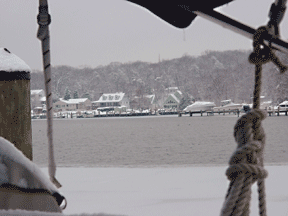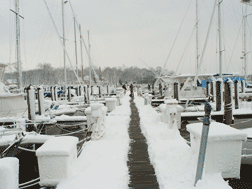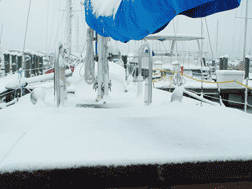 |
||||||||||
|
||||||||||
|
||||||||||
Lay Up, Close Up or Cozy Up
|
||||||||||
A Pair of Don’ts1. Don’t blow your lines using compressed air. More than one boater has discovered this is a great way to blow out critical connections, resulting in serious clean-up and repair costs. 2. Don’t use gin or vodka in place of anti-freeze. Yes, sadly, there were some old salts who claimed this is a cheaper way to keep lines from freezing. Some even said you could drink it come the spring thaw. Alcohol is both corrosive and flammable. Thus there were some old salts. |
Clean everything you can before closing up your boat, whether in or out of the water. This includes refrigerators, freezers, all cabinets and drawers and other bulk storage spaces. Leave cupboard, closet, cabinet doors and drawers open to maximize ventilation and reduce mold and mildew formation.
After cleaning the head and pumping out the holding tank, fill the commode with nontoxic anti-freeze and pump through into the holding tank.
Make sure that all deck drains and scuppers are clean and unobstructed. More than one boat has suffered serious water damage from storm water that ended up in the cabin because of clogged drains.
If you have a sailboat, remove sails and store them properly, being careful to not fold or crease tightly, and keep in a dry place. If you are laying up your sailboat, then it’s generally wise to remove the mast and rigging. In any case, lines should be removed, cleaned and stored.
Before you lock up, remove all gear that you don’t need, including cushions, bedding, clothing and any other items that might attract mold and mildew.
Finally, there’s the matter of covering up your boat. Durable, reusable canvas is most economical in the long term, and the best way to go, especially if you are leaving your boat in the water and intend to spend any time on it during the winter.
A final word if you leave your boat in the water: Ice-eater. The best and easiest way to assure your hull remains ice-free is to purchase one at any boating supply store. A motor with an impeller that you submerge under your boat, an ice-eater draws warmer water up from the bottom and circulates it to keep ice away from your boat. It’s very economical to use, and just one will do the job for most boat slips.
If you’re hauling out to lay up, then shrink-wrapping is an option. Hire qualified professionals, because it’s not as simple as the finished product makes it look.
Other boaters, generally sailboaters, have removable wooden frameworks they place over their decks and cover with heavy plastic, which can be done whether the boat is in or out of water.
Of course, there are many boaters who don’t cover their boats at all, and as long as the vessel is secure from water entering the cabin, or swamping the hull, then that’s just fine. But most of these people regularly check on their boats, especially after rain or snowstorms, to make sure there are no surprise leaks.
Yes, it takes time and work to do it right. The alternative is a big mess and possible damage to your boat by spring. Of course, if your budget allows, you can hire professionals to do all or part of this winterizing for you. If you aren’t sure what to do or how to do something, then it’s worth paying someone who does know.
Labs Cozy Up
Live-aboards face winter — as they do life in general — differently from other boaters. For them, winter is simply another season, requiring a few minor adjustments to lifestyle.
Aside from food, heat and water are the top requirements for survival in winter. Some boats have heat sources built in, but many do not. Labs have to arrange for that. There are kerosene heaters, ventless propane units, and electric heaters, useful where there is sufficient access to shore or generator power. Some boats have reverse-cycle water systems usable for both cooling and heating. Like traditional heat pumps, they become less efficient the colder the water temperature becomes, so those who have these systems also have auxiliary heat capability.
Boats are not generally insulated, so Labs will often add insulation for more efficient heating. Hanging light-absorbing tarpaulins over the deck, particularly of a sailboat, will help draw the heat from the winter sun and keep heat inside. Canvas and isinglass enclosed cockpits also help keep heat from escaping the main cabin.
Most boats have freshwater tanks; if there’s access to water for filling these tanks in winter, that’s ideal. Boaters with very small tanks or who dock near no freshwater access buy bottled water. Some Labs use tank water for dishes and bathing and purchase bottled water for drinking and cooking.

Whither Winter?
With their boats winterized; what do boaters do all winter?
Wenders who have normal lives on the hard — land — simply trade boating weekends for other pastimes. A few will visit their boats occasionally during the big chill.
Stabs and labs, however, tend to behave differently once the frost moves in. Many stabs keep boats in the Bay through summer; some have homes in the warmer, sunnier south and migrate there in the winter. Others have travel trailers, land schooners as it were, and travel south to RV parks. And many stabs who have homes near their boats simply do as wenders: Go to land and use their wintertime differently.
Labs can be divided into two main groups: those who cruise part of the time and those who cruise most or all of the time. Fulltime cruising live-aboards do just that, and all they do in winter is cruise to warmer climes, like the Caribbean.
Labs who only cruise part of the time, such as people still working regular jobs and in port most of the year, generally just cozy up on their boats and do the same things wenders do. They go out to dinner, movies, sporting events, all the things landlubbers do.
Admittedly, there are Labs who enjoy the solitude of winter, in the now-mostly abandoned marinas. They enjoy the sunsets, snow on the docks, watching ice form on the water, keeping an eye on ducks that winter over and occasionally entertaining a friend or two for dinner. These boat people will tell you that winter on a boat on the water is every bit as wonderful as summer.
Finally, serious boat people will admit that while winterizing isn’t a dream, it’s not a nightmare, either. It’s the process of assuring that come summer, their vessels will be as ready as they are for that first warm, sunny cruise on the beautiful Chesapeake Bay.
|
Current Issue \\ Archives \\ Subscriptions \\ Clasified Advertising \\ Display Advertising |
© COPYRIGHT 2007 by New Bay Enterprises, Inc. All rights reserved.

